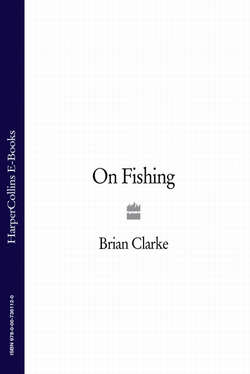Читать книгу On Fishing - Brian Clarke - Страница 13
Coarse Fish on the Move
ОглавлениеOOFFICIALLY it is the salmon and the sea trout that are the ‘migratory fish’ – the fish that begin their lives in rivers and that go to sea before coming back, in turn, to spawn. The rest – eels excepted – are the ‘non-migratory’ species: the stay-at-homes and the moochers-about; the sidlers from this side of the river to that; the fish that limit their forays to a trip to the shallows downstream from time to time, or just occasionally to the deeps around the bend.
That, anyway, is the official view and, as it happens, the view of many anglers. The reality, though, is more complex – and surprising.
BIOLOGISTS have known for years that coarse fish, for all their stick-around reputations, are given to travelling astonishing distances – often at astonishing speeds. It is just that somehow the results of their researches rarely reach the riverbank and even long-established facts will come as news to most on it.
Like, for example, the fact that barbel can range tens of kilometres upstream and downstream in a single season. Like, for example, the fact that bream can leave their daytime swim at dusk, roam several kilometres during the night – and be back where they started off by next morning, leaving the local anglers no wiser.
Research into behaviour like this is highlighted from time to time at fisheries management conferences and when biologists get together, but not on many other occasions. In fact, an Aquatic Animal Research Group at Durham University has been studying fish movements for years. Scientists there have tagged and tracked barbel, chub, dace, bream, roach and a range of other species on the Nidd, the Ouse and the Derwent in Yorkshire, and on other rivers and lakes further south.
Much of this work has been undertaken in an attempt to understand the effects on river life of man-made interventions – from the building of weirs and fish passes to flood prevention works and significant water abstraction. It is the insights into fish behaviour coming out of it all that will fascinate anglers most.
Barbel have been tagged and tracked five and even ten kilometres upstream and down again in a single season, with individual fish undertaking round-trips of 60 kilometres to find suitable spawning gravels. Chub heading upstream for places to spawn have been found to make repeated attempts to use fish passes built for sea trout and salmon – one memorable fish on the Derwent entering a pass seven times in seven nights before finally giving up.
A study of bream on the River Trent revealed that individual shoals covered beats of up to six kilometres long in the course of a season. Within a shoal, different fish would behave differently as dusk approached. Some would leave the ‘home’ reach occupied during the day and move several hundred metres upstream and down in the course of a night. Others would range three and even four kilometres afield and still be back before morning. The extent to which a given reach meets the needs of the fish in it is likely to dictate when, how far and how often fish will travel.
Studies have thrown up other fascinating insights – like the disadvantage of being released into the wild after being bred in captivity. Stocked coarse fish, it seems, can travel at the wrong times. Whereas native fish lie doggo while the sun is up and travel under the cover of darkness, farm-bred fish will shift location in broad daylight.
‘Presumably there is an advantage in native fish moving at night – they may be less susceptible then to predation by birds, pike and otters’, one of the study team has suggested. ‘The movements of reared fish – if they’re looking for food – may reflect the times of day when they’ve been fed in captivity and that could prove a disadvantage.’
It is not only the extent to which fish move and when that is surprising, but also the speeds at which they move. Twelve-hour round-trips of six and eight kilometres by bream are startling enough, but the speeds of other fish – and especially the speeds of small fish relative to the speeds of large – can leave the portly bream standing.
Whereas a metre-long adult salmon can swim at better than two metres a second for hours and days on end – a formidable feat of strength and endurance – tracking has shown that salmon smolts a sixth of that length can sustain close on half a metre a second without difficulty. River lampreys have been recorded travelling 10 kilometres a night upstream, against a steady current – a distance and speed many would find surprising in a fully grown sea-trout.
What does it all amount to for the angler on the bank? In the case of swimming speeds, probably not much, other than to cause him or her to marvel yet again at the wonders of nature. In the case of in-river migration, it will be to cause anglers to see coarse fish in a new way – and to encourage them to be more adventurous in their choices of swim as daylight fades and each season progresses.
Fish movements also throw two of angling’s most commonly heard statements into a new light. The fact that a fishless day for one angler is followed by a night of frenzied action for another in the same place might not be simply because ‘fish come on at night’ – a well-known saw – but because a hitherto fishless swim has had travelling fish come into it.
And the heartfelt ‘there are no bloody fish in this bloody swim’ might sometimes not only be an excuse of a kind but that rarest commodity in angling – the truth.
